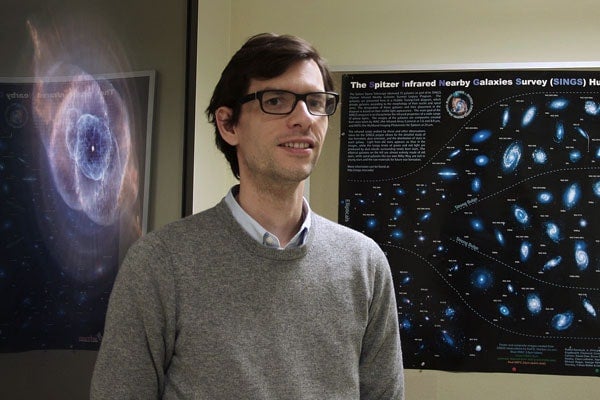
Galactic game-changer receives Sloan Fellowship
Published: February 23, 2016
Jo Bovy looks out his office window towards the billions of stars of the Milky Way. It's daytime, so he can’t actually see those stars. At night, or even out in the pristine blackness of space, our galaxy is so vast that most of it is concealed over great distance.
But for Bovy, it’s the distant, sometimes invisible aspects of our galaxy that fascinate him the most.
“A lot of the most exciting new measurements being made in physics today are in the night sky,” says Bovy, who has received a prestigious Sloan Fellowship to further his investigations into the structure, formation and evolution of the Milky Way.
Along with neuroscientist Christopher Honey, Bovy is one of two U of T Sloan Fellowship recipients this year – both in the Faculty of Arts & Science. The Sloan Fellowships are awarded to 126 non-tenured scholars and scientists around the world annually. Sloan Fellows are expected to be at an early stage of their careers but with a strong body of independent research accomplishments.
Among other achievements, Bovy was instrumental in making the first-ever detailed measurements of the chemical structure of the Milky Way’s disk – the relatively flat arrangement of spiral arms, spurs and other collections of gas, dust and stars beyond the glowing bulge of our galaxy's central nucleus.
“Galaxies are just such huge, majestic structures.... It's amazing to learn how they work over cosmic time,” says Bovy, who holds a Canada Research Chair in Galactic Astrophysics.
To map out the chemistry of the Milky Way, Bovy used data from the New-Mexico-based Apache Point Observatory Galactic Evolution Experiment (APOGEE-1) survey for which he is the Science Working Group Chair.
APOGEE uses high-resolution infrared spectroscopy to look past the dust that obscures parts of our galaxy far from the Solar System, revealing the chemistry of tens of thousands of distant stars in detail that hasn't been possible until the last few years.
“After a single night of observing, we can find out more than we used to in years,” says Bovy.
Using data from another instrument at Apache Point, Bovy has also been able to show that the vertical structure of the Milky Way’s disk is different than what researchers had previously thought.
By separating populations of stars in the disk by their chemical signatures, Bovy was able to show that most of our galaxy’s mass is distributed throughout thin and thick parts of the galactic disk – a departure from the previous theory that most of the structure of the Milky Way’s disk is in a thin part, with a much smaller amount in a single thick component.
Bovy has even become the first researcher to measure the motion of our own star, the Sun, using information from disk stars beyond our immediate stellar neighbourhood, as the stars travel around our galactic nucleus.
By doing so, he discovered that the Sun's orbit around our galaxy is twice as ellipse-shaped as scientists thought. Bovy and team also found that the Sun is inching ahead of nearby stars in its orbit nearly twice as fast as was previously estimated.
While the average speed of the stars moving around the centre of our galaxy is about 220 km/second, Bovy found that the Sun is actually moving about 25 km/s faster – like a person walking down a moving walkway at an airport, adding their own stride to the speed of the walkway.
Over the next two years, Bovy will use his $50,000 Sloan grant to study data from the European Space Agency's Gaia spacecraft, which is creating a 3D map of the locations and motions of roughly 1 billion objects throughout the Milky Way.
Bovy intends to use the velocities of distant stars mapped out by Gaia to figure out how the mass of stars is distributed in the galactic disk, as well as searching for insights into what scientists call the dark matter halo, a hypothetical part of our galaxy that can't be seen but contains 20 times as much mass as all of the stars in the Milky Way.
Bovy says his dream discovery would be to determine how dark matter is distributed on very small scales: “If [that matter] is cold, there should be all these tiny blobs floating around in the Milky Way,” he says. “You wouldn't be able to see them, but I'd love to figure out if it exists that way.”
“I'd like to finish that well before retirement,” Bovy says, chuckling. “In the next 10 years or so would be nice.”



